Leading contributors of carbon dioxide emissions in Germany
INTRODUCTION
It is no longer news that climate change and global warming is fast becoming a global phenomenon for concern and immediate attention (Corwin, 2021; Xi et al., 2021). The gradual warming of the planet is as a result of the earth’s heat radiation trapped within its atmosphere. According to Herndon (2020), this trapped heat is a consequence of gas emissions that produce a greenhouse effect (i.e., retaining heat within a confined space). Hence these gases were termed greenhouse gases, they include carbon dioxide, methane, nitrous oxide, as well as fluorinated gases (US EPA, 2021). Different regions have started experiencing higher sea levels, warming oceans, more intense heat waves, droughts, and storms, significant year-by-year temperature variances and melting glaciers (World Wildlife Fund, n.d.). At this rate, scientists expect these impacts to result in loss of livelihoods, properties and in more severe regions, loss of lives. Country governments and leaders of corporate organisations have now come together to agree on a way forward, salvaging the damage done from decades of greenhouse gas emissions, while improving civilisation and industrialisation without having a negative impact on the environment, the COP26 is one of many international platforms that foster environmental sustainability and sustainable development (United Nations Climate Change, 2021).
With strong connections to greenhouse gas emissions, researchers have acknowledged the substances that drive climate change (Ledley et al., 1999; Bhattacharyya, Munda and Dash, 2020). Of the different greenhouse gases produced by humans, the Intergovernmental Panel on Climate Change has identified carbon dioxide (CO2) as the most potent contributor to global warming (IPCC, 2007). This paper evaluates Germany’s CO2 emission levels over the last three decades, with an interest in the leading contributors to the nation’s CO2 levels. This paper concludes with recommendations to improve the decarbonisation of Germany’s economy.
DISCUSSION
As at 2018, Germany was responsible for about 2% of global CO2 emissions (IEA, 2021). In 2019, the country reduced its total CO2 emissions to 659.1 metric tonne (ibid). As a national government, Germany is one of the countries that have set very ambitious CO2 emission reduction targets. In May 2021, the German Chancellor, Angela Merkel, signed off on the new targets; to reduce emissions by 65% by 2030 with respect to 1990 levels, overriding the initial 55% reduction target (Reuters, 2021).
The plot below shows the percentage split of CO2 emissions in terms of broad sectors in Germany. It can be observed that electricity and heat production is the highest contributors of emissions, with about 40% of Germany’s total emissions (IEA, 2021). The next highest contributor is the transport sector, responsible for about 20% of Germany’s total emissions.
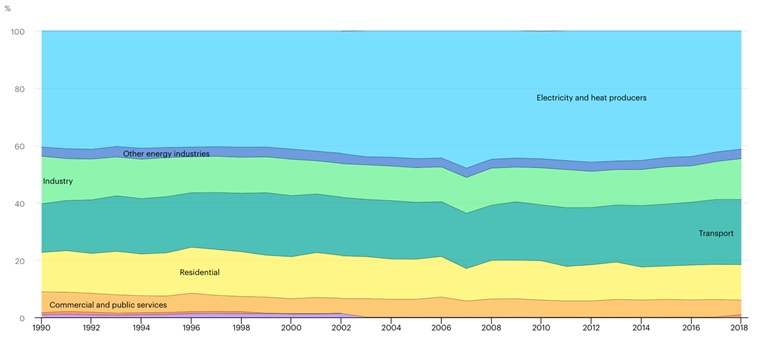
Figure 1: Germany’s CO2 emissions by sector, 1990 – 2018 (IEA, 2021)
Germany has a diverse energy generation mix, comprising of fossil fuel, renewable and nuclear power generation technologies. Figure 2 shows the trend in the country’s different energy supply sources. Coal and oil were the significant sources of energy about three decades ago, with natural gas serving as a supplementary energy source. Since 1990, Germany’s energy reliance on fossil fuel has reduced over the last three decades; energy supplied from coal has reduced by about 57%, while oil has reduced by about 16% in the same period, however, supply from natural gas in 2019 was 146% of 1990 levels (IEA, 2021). Germany’s reliance on fossil fuel is set to reduce further, as the nation is in the process of shutting down over 100 coal-fired powerplants spread across the country by 2038, amounting to a total of 1.5 gigawatts in installed capacity (Mining.com, 2021). Figure 2 also gives an idea of the little contribution of wind, solar and hydro power towards Germany’s energy supply mix, with the contribution from nuclear power gradually dropping since 2010.
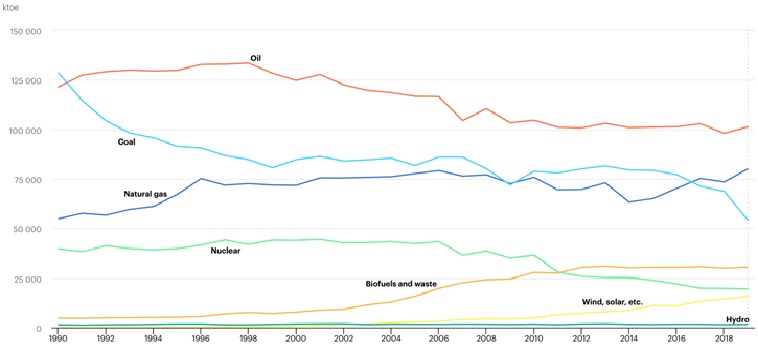
Figure 2: Germany’s total energy supply (TES) by source, 1990 – 2019 (IEA, 2021)
With electricity and heat being the highest contributing sector to Germany’s CO2 emissions, a deep dive was done into the breakdown of electricity and heat generation sources. The breakdown can be seen in figures 3 and 4.
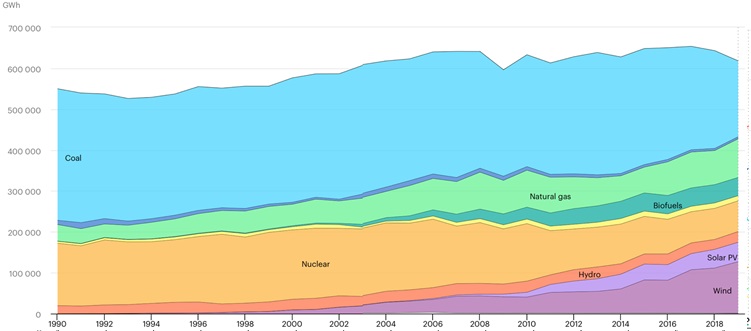
Figure 3: Germany’s electricity generation by source, 1990 – 2019 (IEA, 2021)
From figure 3, it can be observed that electricity is mainly generated from fossil fuels (coal and natural gas), nuclear and wind energy. With the energy generation from nuclear power plants dwindling, it remains to be seen whether Germany’s energy demand can be delivered from renewable energy sources alone, considering the government’s plans to phase out unabated coal power plants in the coming decade.
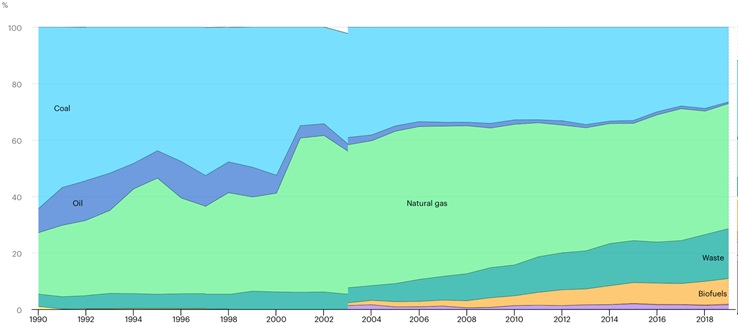
Figure 4: Germany’s heat generation by source, 1990 – 2019 (IEA, 2021)
The plot above is a representation of Germany’s heat generation, in terms of source. With over 70% of the overall energy mix, it can be observed how fossil fuels (coal, oil and natural gas) dominate the heat generation mix. With energy required to provide space and water heating in German homes, there is a huge void to fill in terms of heat generated from coal and natural gas.
One of the positives from the renewable energy development is the fact that the capital and operational cost for renewable energy technologies have started dropping, as highlighted by IRENA (2021). This fosters the spread and adoption of renewables globally, as seen in the rapid rate at which China’s power system is being decarbonised (He et al., 2020). However, there is need for more innovation in this space for faster decarbonisation of industrial and energy-intensive economies like Germany.
The plot below shows Germany’s research and development (R&D) budget for different energy technologies from 1990 to 2019. The R&D budget for nuclear energy has taken a huge hit in Germany, with major diversions being made to R&D that support renewable energy technologies. Hydrogen and fuel cells technologies have not experienced significant increases in their budgets despite records of research breakthroughs in this space (Federal Ministry for Economic Affairs and Energy, 2020).
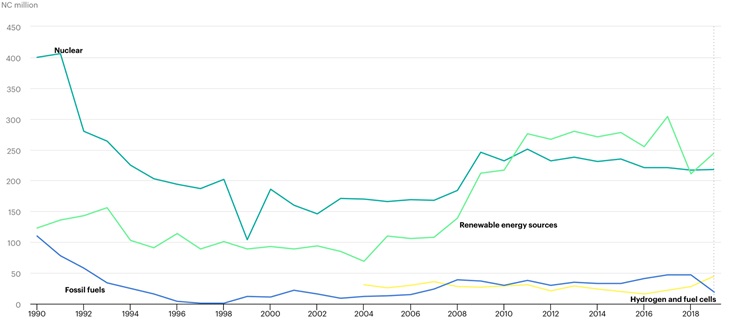
Figure 5: Germany’s RD&D budget per technology group in national currency, 1990 – 2019 (IEA, 2021)
CONCLUSION
The German government has publicly expressed their determination in combating climate change by tackling the major drivers of global warming (CO2 emissions). To this front, the Chancellor has set clear and defined emission reduction targets, with action items surrounding the phasing out of coal power plants, one of the major contributors to the nation’s CO2 emission levels. However, these power plants represent a significant proportion of the energy supply capacity in Germany, and it remains to be seen whether the country can generate sufficient electricity and heat to meet the national demand from alternative sources. Germany needs to increase their development and adoption of renewable energy technologies in the energy supply mix, more innovation is required, and attention must also be placed on alternative energy sources like fuel cells and hydrogen for transportation, which is another major contributor to Germany’s emission levels.
REFERENCES
Bhattacharyya, P., Munda, S. and Dash, P.K., (2020) Climate change and greenhouse gas emission. New India Publishing Agency, New Delhi, 110088, India.
Corwin, D.L., (2021) Climate change impacts on soil salinity in agricultural areas, European Journal of Soil Science, 72(2), pp.842-862.
Federal Ministry for Economic Affairs and Energy (2020) Breakthrough for fuel cell mobility. Available at: https://www.german-energy-solutions.de/GES/Redaktion/EN/News/2020/20200121-fuelcell.html [Accessed: 28 August 2021].
He, G., Lin, J., Sifuentes, F., Liu, X., Abhyankar, N. and Phadke, A., (2020) Rapid cost decrease of renewables and storage accelerates the decarbonization of China’s power system, Nature communications, 11(1), pp.1-9.
Herndon, J.M., (2020) True Science for Government Leaders and Educators: The Main Cause of Global Warming, Advances in Social Sciences Research Journal, 7(7).
IEA (2021). Data & Statistics. Available at: https://www.iea.org/data-and-statistics/data-browser/?country=GERMANY&fuel=CO2 emissions&indicator=CO2BySector [Accessed: 28 August 2021].
IPCC (2007) A report of working group I of the Intergovernmental Panel on Climate Change: Summary for policymakers. Available at: https://www.ipcc.ch/site/assets/uploads/2018/02/ar4-wg1-spm-1.pdf [Accessed: 28 August 2021].
IRENA (2021) Majority of New Renewables Undercut Cheapest Fossil Fuel on Cost. Available at https://www.irena.org/newsroom/pressreleases/2021/Jun/Majority-of-New-Renewables-Undercut-Cheapest-Fossil-Fuel-on-Cost [Accessed: 28 August 2021].
Ledley, T.S., Sundquist, E.T., Schwartz, S.E., Hall, D.K., Fellows, J.D. and Killeen, T.L., (1999) Climate change and greenhouse gases, Eos, Transactions American Geophysical Union, 80(39), pp.453-458.
Mining.com (2021) Germany to shut down 1.5 GW of coal generation by December. Available at: https://www.mining.com/germany-to-shut-1-5-gw-of-coal-generation-by-december/ [Accessed: 28 August 2021].
Reuters (2021) German cabinet agrees more ambitious CO2 cuts before September election. Available at: https://www.reuters.com/world/europe/german-cabinet-passes-plans-more-ambitious-co2-cuts-govt-source-2021-05-12/ [Accessed: 28 August 2021].
United Nations Climate Change (2021) UN Climate Change Conference UK 2021. Available at: https://2nsbq1gn1rl23zol93eyrccj-wpengine.netdna-ssl.com/wp-content/uploads/2021/07/COP26-Explained.pdf [Accessed: 28 August 2021].
US EPA (2021) Overview of Greenhouse Gases. Available at: https://www.epa.gov/ghgemissions/overview-greenhouse-gases [Accessed: 28 August 2021].
World Wildlife Fund (n.d.) Effects of Climate Change | Threats. Available at: https://www.worldwildlife.org/threats/effects-of-climate-change [Accessed: 28 August 2021].
Xi, Y., Peng, S., Ciais, P. and Chen, Y., (2021) Future impacts of climate change on inland Ramsar wetlands, Nature Climate Change, 11(1), pp.45-51.